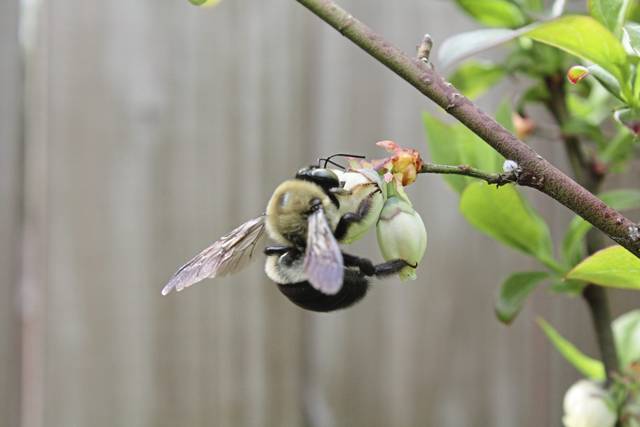Get the scoop on blueberry pollination
Spring is a busy time for gardeners, but if you’re a blueberry grower, I encourage you to take the time to head out to the garden to observe one of my favorite spring garden sights: blueberry pollination.
While hives of imported European honeybees are often the pollinators of blueberries grown on commercial farms, native bees provided pollination services to these native shrubs long before European honey bees ever made it to this continent.
There are two main pollinator groups of blueberries: Bumblebees (Bombus spp.) and mining bees (Adrena spp.), though other native bees feed from their flowers, too, including the sneaky carpenter bees I’ll tell you about in a bit. I love to watch my blueberry bushes when they’re in flower to see which species of bees visit the blooms.
Most types of blueberries require the presence of a cross-pollination partner of another variety to produce more and larger berries. This pollen exchange is facilitated entirely by bees. Bumblebees are four times more effective at pollinating blueberries than honey bees, and the timing of the blueberry bloom coincides with the emergence of overwintered bumblebee queens.
In early spring when the blueberries are in bloom, if you spy a bumblebee foraging on the flowers, it’s most likely a fertilized queen bumblebee who has spent the winter under a log or a pile of leaf litter somewhere nearby. As the bumblebee queens forage, they also begin to build their new colonies, making blueberries a valuable early season food source for this wonderful native bee.
Bumblebees perform something known as buzz pollination on blueberry flowers. They knock the pollen loose in the flowers by vibrating their flight muscles very fast. Amazingly, buzz pollination takes place at the same frequency as a middle C. This is why you can hear a slight buzzing sound when bumblebees are drinking nectar from flowers, while there’s no sound when other bee species are sipping from blooms. The loose pollen is then moved from flower to flower as the bumblebee goes about its business.
A Maine study showed that dense plantings of pollen- and nectar-rich plants located close to blueberry bushes increased native bee populations and therefore blueberry pollination rates. This means you should have as many early flowering plants in and around your blueberry bushes as possible.
Though they’re often confused with bumblebees, carpenter bees can also be observed on blueberry plants. Carpenter bees are slightly larger than bumblebees and their abdomens are shiny black, rather than being fuzzy like a bumblebee. Another easy way to tell them apart on blueberry plants is that carpenter bees are nectar thieves. Instead of accessing the nectar by going up through the open end of the flower, like bumblebees do, carpenter bees are too heavy to rest properly on the flower and access nectar this way. Instead, they slit a hole at the base of the blueberry bloom, insert their tongue, and sip the nectar through the hole. In other words, they drink the nectar without providing pollination services. Occasionally, other bee species will then use the same hole for an easy hit of nectar.
It’s fun to watch the carpenter bees cheating and stealing nectar, though. And thankfully, the blueberries still get pollinated because there are always plenty of bumblebees around to do the real work. Take the time to sit in the garden and watch the buzz of life you’ll find there. It’s fascinating stuff!
Horticulturist Jessica Walliser is the author of several gardening books, including "Attracting Beneficial Bugs to Your Garden," "Good Bug, Bad Bug," and her newest title, "Container Gardening Complete." Her website is jessicawalliser.com. Send your gardening or landscaping questions to tribliving@tribweb.com or The Good Earth, 622 Cabin Hill Drive, Greensburg, PA 15601.
Remove the ads from your TribLIVE reading experience but still support the journalists who create the content with TribLIVE Ad-Free.

